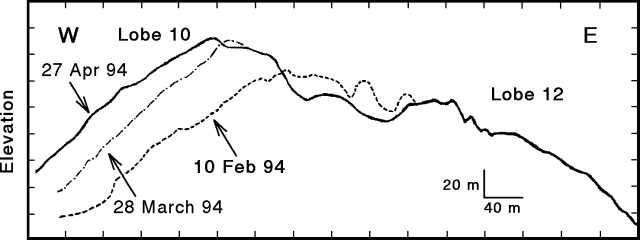Report on Unzendake (Japan) — April 1994
Bulletin of the Global Volcanism Network, vol. 19, no. 4 (April 1994)
Managing Editor: Richard Wunderman.
Unzendake (Japan) High seismicity but few pyroclastic flows; continued dome deformation
Please cite this report as:
Global Volcanism Program, 1994. Report on Unzendake (Japan) (Wunderman, R., ed.). Bulletin of the Global Volcanism Network, 19:4. Smithsonian Institution. https://doi.org/10.5479/si.GVP.BGVN199404-282100
Unzendake
Japan
32.761°N, 130.299°E; summit elev. 1483 m
All times are local (unless otherwise noted)
At Unzen the output of lava remained about the same as in previous months, yet the edifice first inflated then deflated, the direction of dome growth reversed, and the paths of pyroclastic flows changed. Recently, seismicity remained high while the number of seismically detected pyroclastic flows remained unusually low (figure 69).
Dome growth shifted direction between late-April, when the dome continued to expand northward, and early-May, when it began to expand southward. The late-April growth involved both the upper surface of the dome (the carapace) and the adjacent talus; they both moved nearly horizontally toward the NNW at about 1-2 m/day. The later, southerly motion also reached a similar speed.
Crest-line measurements determined by theodolite from the UWS documented deformation on the W side of the dome (figure 70). These three sequential profiles of the lava dome illustrate the subhorizontal, westward movement of the W dome margin.
 |
Figure 70. Profile of the Unzen lava dome determined by theodolite measurements from about 2 km SSW of the dome. Courtesy of JMA. |
In mid-May a split in the dome top formed an E-W trending graben: 200 m long, 50 m wide, and 20 m deep. The graben severed and offset the dome; the dome's S part moved S while the N part subsided. Rockfalls frequently bounded down the dome's upper slopes, chiefly from the unstable, advancing face of the dome. During the shift in growth direction there was neither high seismicity nor a break in the rate of eruption (which remained below ~50,000 m3/day).
A spiny cone sprouted in February 1994. It underwent rapid growth, reaching the top of the talus pile in early April (19:2-3). It subsequently began a day-by-day collapse.
EDM measurements by the GSJ recorded Unzen's inflation and deflation. On the S flank no clear pattern emerged. In contrast, the distance between sites on the dome floor (100-150 m NW of talus) and Unzen's NW flank indicated that the volcano inflated until 29 April, when it suddenly began deflating. Deflation continued until at least mid-May. This inflation followed by deflation took place a few days prior to the shift in the growth direction of the dome, suggesting a possible relationship.
During mid- to late-April pyroclastic flows were similar in number to March. Attributed to partial collapse of the N part of the dome, the flows frequently descended the N flank.
On 26 April several of these N-directed pyroclastic flows traveled a horizontal distance of 2.1 km from their source. For the distal 0.8 km of their path, these flows were guided by two valleys with widths of tens of meters. Observers inspected the resultant deposits the next day from a helicopter. The deposits contained large blocks only as far as the heads of the small valleys; these block-rich facies were associated with a zone of toppled trees that extended ahead of the deposits. Above the valleys, a seared zone extended 100-200 m beyond the deposits. In the valleys, the seared zone only continued several tens of meters beyond the deposits. The portions of the flows guided by valleys are thought to have behaved as pyroclastic surges, conveyed in a manner similar to that seen along the Mizunashi and Nakao rivers in June and July 1993. Since early February, N-directed pyroclastic flows have had an estimated maximum total volume of 1.2 million m3.
Although pyroclastic flows traveling N were also common in late-April, beginning in the evening of 2 May they ceased and flows began to travel SE instead. One such SE-directed flow, on 3 May, followed the Akamatsu Valley. Later, in mid-May, SW-directed pyroclastic flows became common. Rockfalls occurred in Unzen's southern quadrant but they failed to develop into pyroclastic flows because the prehistoric lava dome broke their descent. On 12 May pyroclastic flows cascaded for ~1 km, moving down the length of a large gully S of the volcano. They came to a halt at the lower end of the gully, having retraced a route not used since 20 January.
In April, a high number of microearthquakes occurred beneath the lava dome. A large number of earthquakes also took place in March (5,110) and April (4,606) (figure 69). Over 3,000 people have remained evacuated since the eruption and associated pyroclastic flows began 1991, an interval of more than 1,000 days.
Geological Summary. The massive Unzendake volcanic complex comprises much of the Shimabara Peninsula east of the city of Nagasaki. An E-W graben, 30-40 km long, extends across the peninsula. Three large stratovolcanoes with complex structures, Kinugasa on the north, Fugen-dake at the east-center, and Kusenbu on the south, form topographic highs on the broad peninsula. Fugendake and Mayuyama volcanoes in the east-central portion of the andesitic-to-dacitic volcanic complex have been active during the Holocene. The Mayuyama lava dome complex, located along the eastern coast west of Shimabara City, formed about 4000 years ago and was the source of a devastating 1792 CE debris avalanche and tsunami. Historical eruptive activity has been restricted to the summit and flanks of Fugendake. The latest activity during 1990-95 formed a lava dome at the summit, accompanied by pyroclastic flows that caused fatalities and damaged populated areas near Shimabara City.
Information Contacts: S. Nakada, Kyushu Univ; JMA.


